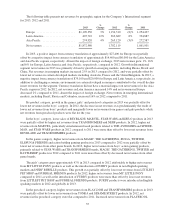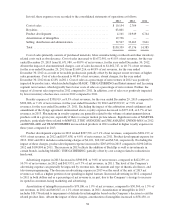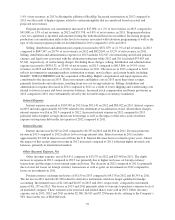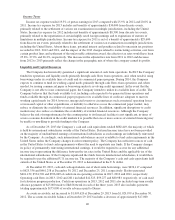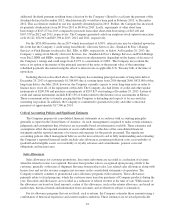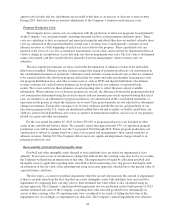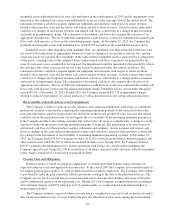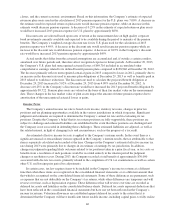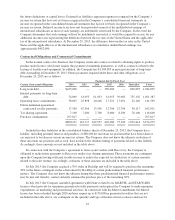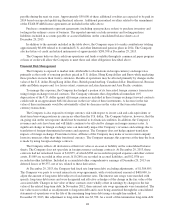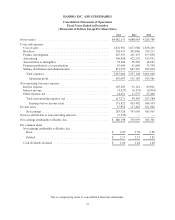Hasbro 2013 Annual Report Download - page 55
Download and view the complete annual report
Please find page 55 of the 2013 Hasbro annual report below. You can navigate through the pages in the report by either clicking on the pages listed below, or by using the keyword search tool below to find specific information within the annual report.
additional dividend payment resulting from a decision by the Company’s Board to accelerate the payment of the
dividend declared in December 2012, which historically would have been paid in February 2013, to December
2012. This acceleration resulted in one less quarterly dividend paid in 2013. Further, the Company has increased
its quarterly dividend rate from $0.30 in 2011 to $0.40 in 2013. Lastly, repayments of other short-term
borrowings of $215,273 in 2013 compared to proceeds from other short-term borrowings of $43,106 and
$167,339 in 2012 and 2011, respectively. The Company generated cash from employee stock option transactions
of $118,122, $54,963 and $29,798 in 2013, 2012 and 2011, respectively.
For the $350,000 in notes due in 2017 which bear interest at 6.30%, interest rates may be adjusted upward in
the event that the Company’s credit rating from Moody’s Investor Services, Inc., Standard & Poor’s Ratings
Services or Fitch Ratings is reduced to Ba1, BB+, or BB+, respectively, or below. At December 29, 2013, the
Company’s ratings from Moody’s Investor Services, Inc., Standard & Poor’s Ratings Services and Fitch Ratings
were Baa2, BBB and BBB+, respectively. The interest rate adjustment is dependent on the degree of decrease of
the Company’s ratings and could range from 0.25% to a maximum of 2.00%. The Company may redeem the
notes at its option at the greater of the principal amount of the notes or the present value of the remaining
scheduled payments discounted using the effective interest rate on applicable U.S. Treasury bills at the time of
repurchase.
Including the notes described above, the Company has remaining principal amounts of long-term debt at
December 29, 2013 of approximately $1,384,895 due at varying times from 2014 through 2040. $425,000 of this
long-term debt is due May 2014; however, the Company currently expects to issue long-term notes in order to
finance most, if not all, of the repayment of this debt. The Company also had letters of credit and other similar
instruments of $209,398 and purchase commitments of $297,817 outstanding at December 29, 2013. Letters of
credit and similar instruments include $187,130 of bonds related to the defense of tax assessments in Mexico.
These assessments relate to transfer pricing that the Company is defending and expects to be successful in
sustaining its position. In addition, the Company is committed to guaranteed royalty and other contractual
payments of approximately $17,560 in 2014.
Critical Accounting Policies and Significant Estimates
The Company prepares its consolidated financial statements in accordance with accounting principles
generally accepted in the United States of America. As such, management is required to make certain estimates,
judgments and assumptions that it believes are reasonable based on information available. These estimates and
assumptions affect the reported amounts of assets and liabilities at the date of the consolidated financial
statements and the reported amounts of revenues and expenses for the periods presented. The significant
accounting policies which management believes are the most critical to aid in fully understanding and evaluating
the Company’s reported financial results include sales allowances, program production costs, recoverability of
goodwill and intangible assets, recoverability of royalty advances and commitments, pension costs and
obligations and income taxes.
Sales Allowances
Sales allowances for customer promotions, discounts and returns are recorded as a reduction of revenue
when the related revenue is recognized. Revenue from product sales is recognized upon passing of title to the
customer, generally at the time of shipment. Revenue from product sales, less related sales allowances along with
license fees and royalty revenue comprise net revenues in the consolidated statements of operations. The
Company routinely commits to promotional sales allowance programs with customers. These allowances
primarily relate to fixed programs, which the customer earns based on purchases of Company products during the
year. Discounts and allowances are recorded as a reduction of related revenue at the time of sale. While many of
the allowances are based on fixed amounts, certain of the allowances, such as the returns allowance, are based on
market data, historical trends and information from customers and are therefore subject to estimation.
For its allowance programs that are not fixed, such as returns, the Company estimates these amounts using a
combination of historical experience and current market conditions. These estimates are reviewed periodically
43




